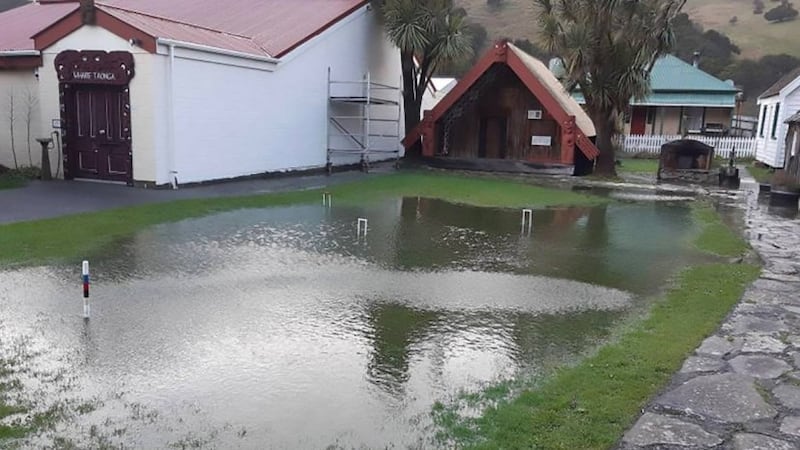By Stuff reporter Jody O'Callaghan. Photo / Stuff.
Okains Bay Museum, which displays some of Aotearoa's rarest and nationally significant taonga Māori, needs money to replace rusted spouting “so old, it should be in our collection”.
The small Banks Peninsula complex is plagued by flooding on its grounds after heavy rain and gaping holes in rusted drains on its buildings that began as a passion project of Murray Thacker in 1977.
Museum leaders say while it desperately needs money to plug the leaks, there is no risk of damage to the taonga.
Okains Bay Museum general manager Wendy Riley said the “munted” drains had become more apparent with recent heavy rain.
During a recent visit from German tourists from a cruise ship, staff had to cone off parts of the grounds due to surface flooding.
”This is not a good look, we need to desperately do something.”
The museum was selected for The Funding Network NZ’s Generosity Generator Programme, which helped it design its grassroots crowdfunding campaign “Stop the Leaks” running on Givealittle until May 12.
It had been “band-aiding the problems” until now, and its priority was repairing spouting on the whare taonga, whare waka, and the colonial hall where parts had to be removed due to the risk of them falling, Riley said.
“It's not yet winter, and recent heavy rains and winds have highlighted that the museum’s ageing drainage systems are not fit for purpose.
“First off on a bucket list of overdue repairs is replacing the severely rusted guttering – so old, it should be in our collection,” Riley said.
The museum had so far raised two-thirds of the $15,700 needed to replace spouting on the buildings that contain its taonga Māori and Banks Peninsula collections.
“People love the collections and want to see them preserved and accessible.”
Museum board chairperson and Te Rūnanga o Ngāi Tahu representative Helen Brown wanted to assure the public that the taonga were safe, and no water was making its way into the interior.
'The protection and care of the collections is paramount for both the museum board and staff.
”In our role as kaitiaki of the collection, we are ensuring at all times that the taonga are safe.”
But clearly, she said, there were long-standing maintenance issues, and it was difficult for small museums like Okains Bay to obtain funding for its buildings.
”Since [Thatcher] passed away, the operation of the museum has become more challenging because [he] was the museum’s primary benefactor in times of need. When the museum needed some extra funding, he would put his hand in his own pocket.”
Ideally, some of the buildings needed to be rebuilt “but that’s not quite within the budget”.
There were also flooding issues on the grounds, which the rusted spouting contributed to, but more money was needed to fix the drainage and stormwater issues the whole valley faced.
The museum also needs money to deal with drainage and stormwater issues that surface with heavy rain.
“With sea level rise, climate change, these are issues that are only going to become increasingly of concern and in need of being addressed.
“This is the first thing we need to do in terms of maintenance of the complex that will make the most difference.”
The taonga Māori collection was the “jewel in the crown” at the museum, which was well-known throughout Aotearoa for its rare, beautiful, and nationally significant pieces, Brown said.
Okains Bay Museum had increasingly been undertaking outreach projects, to take taonga home for visits to local marae to reconnect with hapū.
Recognising the perception of the museum’s remoteness and the museum’s responsibility to reconnect taonga with the land and people from whom they derive, it was “something we want to do more”.
In 2016, Te Papa experts classified the museum’s Taonga Maori to be “a collection of national significance”.


